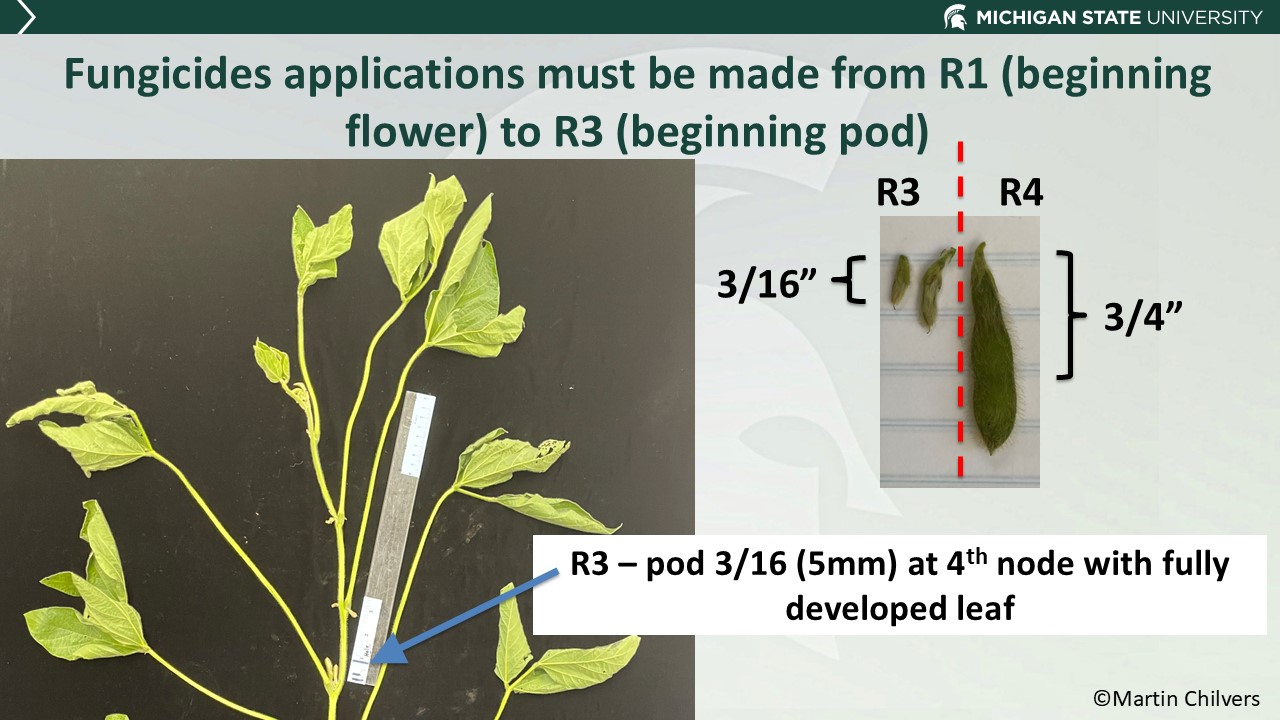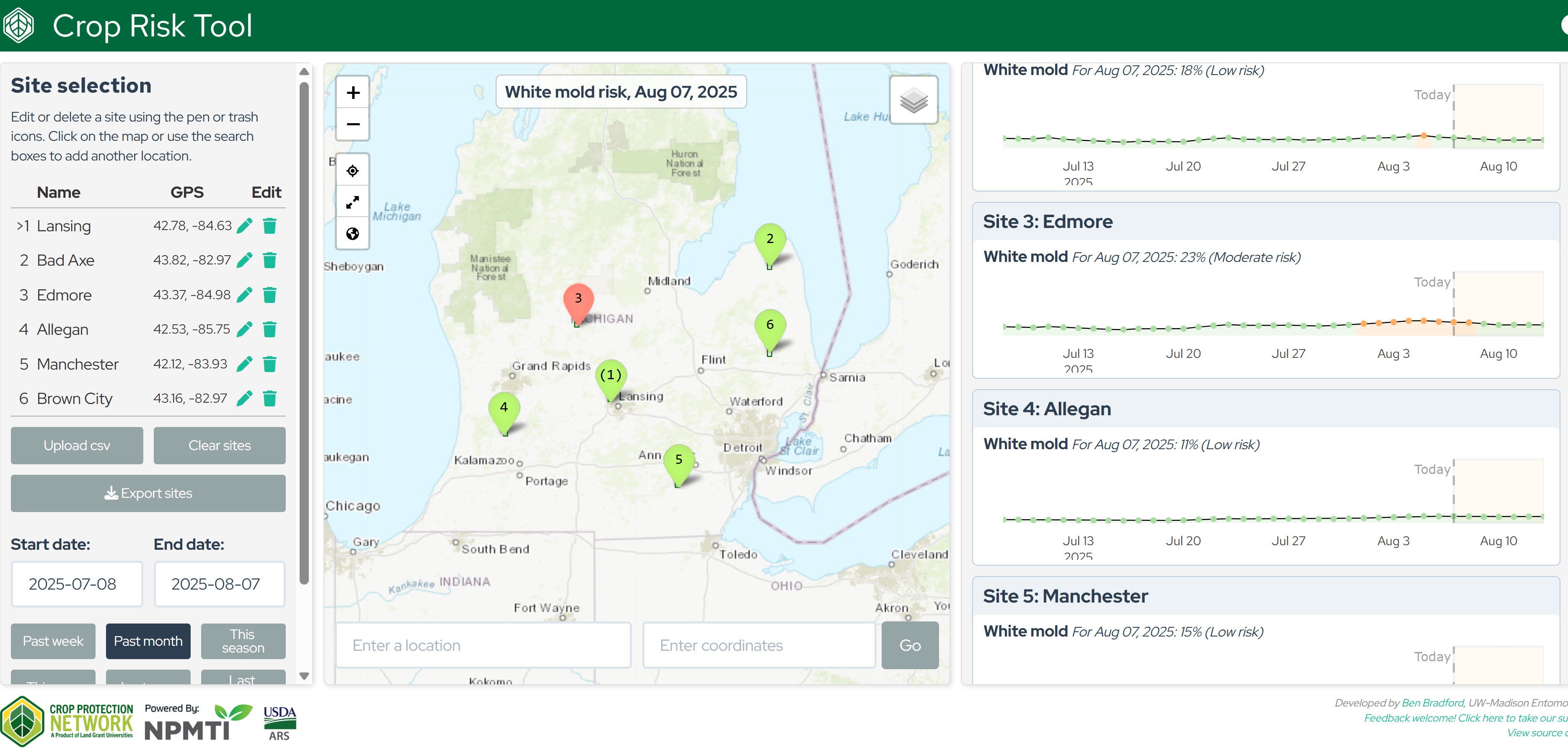Stay ahead of white mold: Mid-season management tactics
Your white mold action plan, from field history to fungicides.

Take-aways
- What is your field history? Fields with a history of white mold will have inoculum potential in future years. It may be wise to treat high risk fields or portions of fields (i.e., low moist areas), particularly if conditions are favorable.
- Understand your varieties. Which varieties are more susceptible to white mold and may benefit from a fungicide?
- Fungicides need to be applied during flowering prior to white mold symptoms, from R1 (beginning of flowering) through R3 (beginning of pod). Once we get to R4 (full pod) growth stage fungicides have little value in white mold management.
- The growth stage is determined by examining pod development at the fourth node from the top. Nodes are counted as those with an open leaf from the top of the plant. A pod at the fourth node that is 3/16 of an inch or longer is at R3 (beginning pod) growth stage, a pod at 0.75 inches or longer is at the R4 (full pod) growth stage.
- Not all fungicides are created equal for white mold management. Each year, researchers review and update the fungicide efficacy chart.
- Use the Crop Disease Forecasting tool, which replaces Sporecaster, to assess risk conditions and to aid in fungicide application timing.
- Leave a check strip if you are making a fungicide application so you can understand your return on investment (ROI). An ROI calculator has been developed for white mold to aid in fungicide decision making.
What is white mold?
White mold, also known as Sclerotinia stem rot caused by the fungus Sclerotinia sclerotiorum, is a potentially devastating disease capable of causing significant yield losses. Symptoms of white mold often begin in August as bleached lesions on the stem, followed by fluffy mycelial growth and then the production of sclerotia (black resting bodies) on or in stems and pods. Unfortunately, at the time of visible symptom development, it’s often too late for an effective fungicide application.
What leads to the development of white mold?
Disease outbreaks of white mold occur when three key factors align: the presence of a susceptible host, field history of disease, and favorable environmental conditions, particularly cool (less than 85 degrees Fahrenheit), moist weather during flowering. Sclerotia resting bodies in the soil germinate to produce apothecia which release spores that infect through flower petals. However, don’t be tricked into confusing harmless mushrooms such as the birds nest fungus with Sclerotinia apothecia. In fact, these Sclerotinia apothecia are so hard to find that they are often not a good scouting tool.

Which fields should I target for management?
Field history is one of the most important considerations. Target fields that have a history of white mold. The sclerotia resting structures can survive for up to 10 years in soil. Although tillage can initially bury sclerotia, subsequent tillage will bring sclerotia close enough to the soil surface where they can germinate. Studies have demonstrated that long term no-till fields tend to be at lower risk to white mold.
Additionally, variety susceptibility is an important component. Although no varieties are immune to white mold, variety selection can make a huge difference. It’s a good idea to look up your varieties susceptibility/resistance scores to understand where you may have greater challenges if disease favorable conditions align.
When should fungicides be applied?
The best fungicide timing is from the beginning of flowering (R1) through the beginning of pod development (R3). Once we hit the full pod (R4) growth stage, fungicides will not be as effective in suppressing disease. To differentiate the R3 from the R4 growth stage, start at the top of the plant and identify the first fully open leaf. Now including that node, count down four nodes and look at the size of the developing pod at the fourth node. If that pod is at or greater than 3/16 inches (5 millimeters), it’s at the R3 growth stage. Once the pod is more than 0.75 inches (2 centimeters), it’s at the R4 growth stage and fungicides will be far less effective.

What about disease forecasting tools?
The Crop Protection Network has introduced the Crop Risk Tool, a free, web-based resource designed to help soybean growers make timely, informed decisions for managing foliar diseases. Built on years of field data and research, the tool uses local weather inputs to forecast the risk of white mold. It provides daily risk updates and a seven-day forecast to support fungicide applications during critical growth stages. The tool accounts for variations in dryland and irrigated environments and is easily accessible through the Crop Protection Network website, where additional resources like fungicide efficacy tables and disease identification guides are also available.

Which fungicides should be applied?
The fungicide efficacy tool hosted on the Crop Protection Network lists fungicides and their efficacy for white mold. Fungicide products ranked as good for white mold suppression include Endura, Approach (in a two-pass system), Omega and Propulse. In our small plot work, we also have good success with the herbicide Cobra, which often performs as well as the best fungicides under high white mold disease pressure. However, farmers should note there is the potential for burn, and some yield loss under conditions that don’t favor disease.
What is my ROI? Leave a check strip!
If you do decide to make a fungicide application(s), be sure to leave check strips and pencil out the costs and benefits, otherwise you will never know what your ROI was. It’s always important to pay attention to what is working for you and what is not. At the Crop Protection Network, we’ve assembled multistate fungicide trial data into a fungicide ROI calculator. The calculator will help examine the potential economic benefits by examining input costs, market price and production outcomes. These ROI calculators are intended to support the decision-making process. It’s important to note that these are not predictive, but they provide a framework for exploring trial data.
Are there other considerations?
Foliar fungicides can be an effective tool for managing white mold. However, they are only one of the tactics available and should be used in combination with other white mold management practices such as partially resistant varieties, wide rows, reduced planting rates, irrigation water management and appropriate tillage method. Be sure to make note of which fields develop white mold for future planning. Also, if you are investing in a fungicide, be sure to leave check strips to pencil out the economics.
Each year, Michigan State University Extension screens varieties and tests new fungicide products, biologicals and amendments. The most promising of these are brought to on-farm research trials in collaboration with the Michigan Soybean Committee and Eric Anderson, soybean educator with Michigan State University Extension. If you are interested in a particular product, we would like to hear from you, so please reach out.
If you have questions about field crop disease management, don’t hesitate to contact me at chilvers@msu.edu.
This work was supported in part by the Michigan Soybean Committee Corn, Project GREEEN and MSU AgBioResearch.



 Print
Print Email
Email